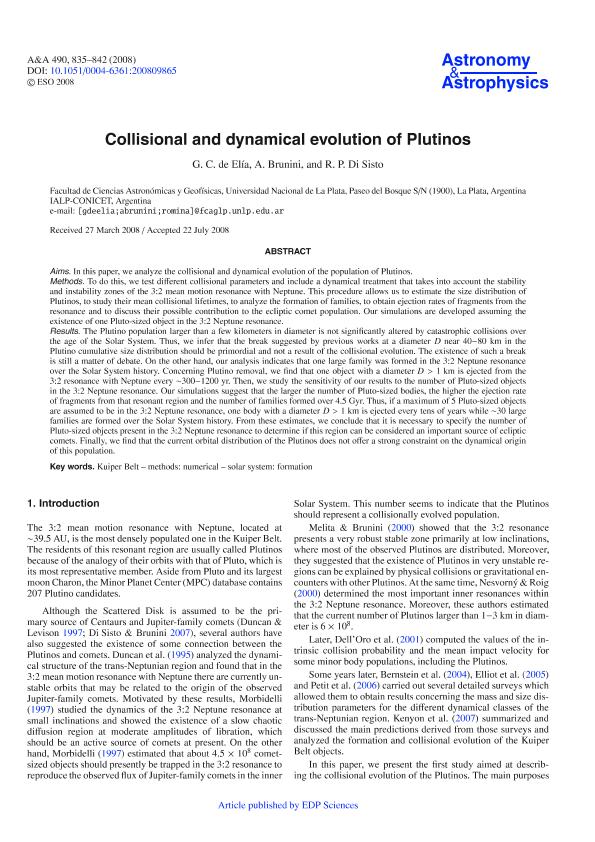Artículo
Collisional and dynamical evolution of Plutinos
Fecha de publicación:
07/11/2008
Editorial:
EDP Sciences
Revista:
Astronomy and Astrophysics
ISSN:
0004-6361
Idioma:
Inglés
Tipo de recurso:
Artículo publicado
Clasificación temática:
Resumen
Aims. In this paper, we analyze the collisional and dynamical evolution of the population of Plutinos. Methods. To do this, we test different collisional parameters and include a dynamical treatment that takes into account the stability and instability zones of the 3:2 mean motion resonance with Neptune. This procedure allows us to estimate the size distribution of Plutinos, to study their mean collisional lifetimes, to analyze the formation of families, to obtain ejection rates of fragments from the resonance and to discuss their possible contribution to the ecliptic comet population. Our simulations are developed assuming the existence of one Pluto-sized object in the 3:2 Neptune resonance. Results. The Plutino population larger than a few kilometers in diameter is not significantly altered by catastrophic collisions over the age of the Solar System. Thus, we infer that the break suggested by previous works at a diameter D near 40-80 km in the Plutino cumulative size distribution should be primordial and not a result of the collisional evolution. The existence of such a break is still a matter of debate. On the other hand, our analysis indicates that one large family was formed in the 3:2 Neptune resonance over the Solar System history. Concerning Plutino removal, we find that one object with a diameter D > 1 km is ejected from the 3:2 resonance with Neptune every ∼300-1200 yr. Then, we study the sensitivity of our results to the number of Pluto-sized objects in the 3:2 Neptune resonance. Our simulations suggest that the larger the number of Pluto-sized bodies, the higher the ejection rate of fragments from that resonant region and the number of families formed over 4.5 Gyr. Thus, if a maximum of 5 Pluto-sized objects are assumed to be in the 3:2 Neptune resonance, one body with a diameter D > 1 km is ejected every tens of years while ∼30 large families are formed over the Solar System history. From these estimates, we conclude that it is necessary to specify the number of Pluto-sized objects present in the 3:2 Neptune resonance to determine if this region can be considered an important source of ecliptic comets. Finally, we find that the current orbital distribution of the Plutinos does not offer a strong constraint on the dynamical origin of this population. © ESO 2008.
Palabras clave:
Kuiper Belt
,
Methods: Numerical
,
Solar System: Formation
Archivos asociados
Licencia
Identificadores
Colecciones
Articulos(IALP)
Articulos de INST.DE ASTROFISICA LA PLATA
Articulos de INST.DE ASTROFISICA LA PLATA
Citación
de Elia, Gonzalo Carlos; Brunini, Adrian; Di Sisto, Romina Paula; Collisional and dynamical evolution of Plutinos; EDP Sciences; Astronomy and Astrophysics; 490; 2; 7-11-2008; 835-842
Compartir
Altmétricas




